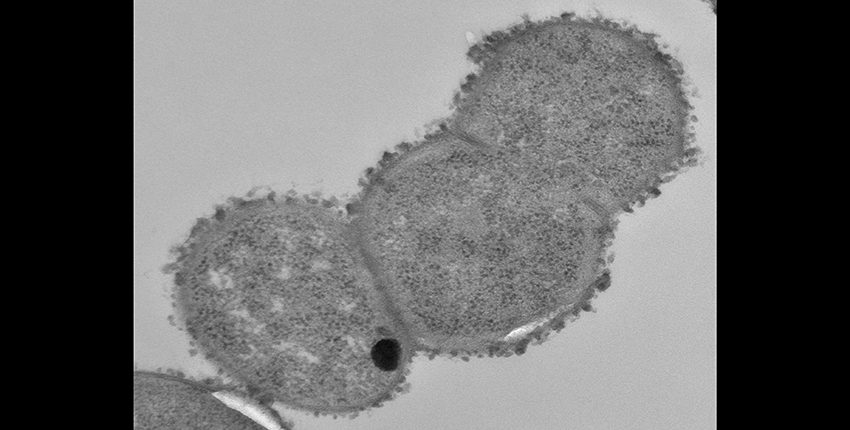
Changes in the gut microbiome have long been linked with Crohn’s disease and other forms of inflammatory bowel disease, but the biology behind those links has remained murky.
Researchers at Harvard Medical School and the Broad Institute of MIT and Harvard have now found that one bacterium associated with Crohn’s disease, Ruminococcus gnavus, produces a certain type of polysaccharide, or chain of sugar molecules, that triggers an immune response.
This study, published June 10 in PNAS, is one of the first to delve into the mechanisms underlying an association between a gut microbe and human disease.
“This is a distinct molecule that represents the potential link between gut microbes and an inflammatory disease,” said first author Matthew Henke, a postdoctoral fellow in the laboratory of senior author Jon Clardy at HMS.
About 2 million Americans live with an inflammatory bowel disease, including Crohn’s.
From correlation to causation
“More and more studies on the correlations between the bacteria in the microbiota and disease were coming out,” said Clardy, the Hsien Wu and Daisy Yen Wu Professor of Biological Chemistry and Molecular Pharmacology in the Blavatnik Institute at HMS. “Some were very strong, some were weak, but it was really all correlations.”
One such study, from the lab of Ramnik Xavier at HMS and the Broad, proved that during some flare-ups of Crohn’s disease, the abundance of R. gnavus can jump from less than one percent of the gut microbiota to more than 50 percent.
That experiment showed that “A is correlated with B,” said Xavier, the Kurt Isselbacher Professor of Medicine in the Field of Gastroenterology at HMS as well as chief of the gastrointestinal unit and director of the Center for the Study of Inflammatory Bowel Disease at Massachusetts General Hospital. “Now the challenge was to get to causation.”
In the new study, Xavier, Clardy, Henke and colleagues wanted to determine whether there were molecular mechanisms by which R. gnavus actually contributes to Crohn’s flare-ups.
Sugary suspect
After growingcolonies of R. gnavus in the laboratory, the team characterized all of the molecules produced by the bacteria to see if any were pro-inflammatory.
One polysaccharide comprised mainly of rhamnose, a sugar not familiar to the human immune system, antagonized the immune system by activating the cytokine TNF-α.
Using a variety of techniques borrowed from chemistry, Henke determined that the polysaccharide was made of two different sugars: chains of glucose protruding from a spine made of rhamnose.
After uncovering the structure, they searched the genome of R. gnavus and identified the genes responsible for making the polysaccharide.
Future experiments will study if these genes are overexpressed before a flare-up of Crohn’s.
“If we can track a single patient and see that the genes for this polysaccharide become expressed before disease symptoms get worse, that’s really powerful,” said Henke. “That would suggest that maybe the polysaccharide is contributing to disease flares.”
Should this theory prove true, the research could inform the development of new treatments for Crohn’s and similar inflammatory diseases by targeting R. gnavus growth or its ability to produce this inflammatory polysaccharide.
Thinking big
The microbiome’s impacts are broad, and these findings have applicability beyond Crohn’s disease, the authors said.
“Now that we’ve established this methodology, we can rapidly go through the other bacteria and find out how the microbiome plays a role in contributing to the chemistry of disease,” said Xavier.
“There’s a lot of really great work being done on cataloging what bacteria, fungi and viruses are in us,” said Henke, “but the health effects of the small molecules and protein products and chemicals that they make haven’t been fully documented yet.”
“We thought for a really long time that microbes had just a passive role in our biology, but that’s definitely changing,” he added.
This study was funded by the National Institutes of Health (grants R01AT009708 and F32-GM126650). Additional support was provided by the U.S. Department of Energy (grant DE-SC0015662). The authors also acknowledge the East Quad NMR Facility and the laboratory of A. Sloan Devlin at HMS.
Chelsi Cassilly in the Clardy lab, Douglas Kenny in the Xavier lab and Hera Vlamakis of the Broad are co-authors of the study. Clardy is a senior associate member of the Broad. Xavier is a core institute member and co-director of the Infectious Disease and Microbiome Program at the Broad.
Adapted from a Broad news story.



